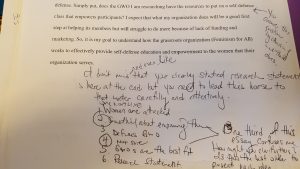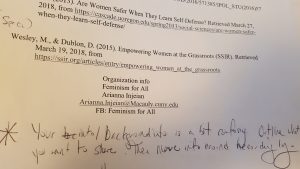This was the hardest assignment for me to complete. I had a hard time organizing my introduction in a way that made sense to others, and for this assignment, it was critical that it could be understood exactly what I was doing. And I think this is one of my common mistakes, but I also needed to include more specifics all throughout the sections. On top of that, there was more than just the introduction that I had to complete. These parts all relied on me finding an organization in an appropriate amount of time, which I did, but it was just another part of the process that went into this comprehensive paper. Everything that went into this paper affected the rest of the semester, so I wanted it to be as good as possible. Below I have included some comments I received on my drafts that were critical in how I moved forward with this paper, finally ending with the end result.


The Grassroots Organization and Self-Defense
Introduction
We are living in a time where our government is attacking women’s rights and safety. This is in terms of having the right to an abortion, and the lack of justice for sexual assault victims, just to name a few issues. In fact, our President has been accused of sexual assault by several women (Shear, 2017). Our society is a patriarchal one and that fact will not be changing anytime soon. So, in times like these when there is a disconnect between the government and the people, many come to rely on outside sources for aid. They may look to local charities, private sector corporations, NGOs, or what this research will look, at grassroots organizations. What we do know is that there is a need to help women be better prepared in situations as simple as walking home at night. But how effective are these outside sources in providing aid to women? Is self-defense a viable option for empowerment for women?
When we talk about ways to empower and protect women, one thing that has been proven to help are with these measures, is self-defense. After taking a course on self-defense, women reported fewer instances of sexual harassment compared to women who had not taken the class (Raleigh, 2013). Self-defense education is important for girls and women to understand how they will be treated in society and how that will affect them throughout their lives. Through self-defense training, women gain this understanding along with more confidence as they know how to protect themselves. Along with that, it challenges the social constructions of femininity as well (Kelly & Sharp-Jeffs). Knowing that one can physically take care of themselves, improves one’s emotional well-being as well. Because of this, it has been shown that the most effective method of empowerment and education is through the women themselves, and how they work together. (Friedman, 2003).
Even though GWOs can help, larger organizations and individuals, promoting issues or making efforts to help a certain group of people, the grassroots organizations (GWOs) are not considered (Wesley & Dublon 2015). GWOs are usually much smaller organizations working on a smaller scale with little to no media recognition, and so they fly beneath many people’s radar. An official definition of grassroots is stated thusly “the common or ordinary people, especially as contrasted with the leadership or elite of a political party, social organization, etc.; the rank and file” (Dictionary, 2018). The grassroots organization is made up of the common people working together to promote a cause they all share. In concept, there is no corporate or governmental funding, only donations from individuals and fundraised money. Even without big money, the GWO can provide some of the most important aid, particularly to women.
Women’s self-defense education and safety can benefit from grassroots organizations (GWOs). Individual women suffer while waiting for policy changes that would protect them, and even when policy changes are made, the effects do not always reach certain communities. Particularly communities of color, which are already affected by institutional racism. The GWOs can provide necessary self-defense education and classes to promote these factors when either governments cannot or will not. The benefits of being community-based are that these GWOs can focus on the actual women. They can focus on their lives and target their specific needs. For example, if the GWO is working in a primarily Muslim community they can target their self-defense classes at hijabi women, who may have to protect themselves in religious-based crimes. But also they have the extra tool of their hijab which could be used in their self-defense. Often, we see GWOs be started in and serve the community in which the organizer is from. So, when women work together in their community, they can make strides in supporting the other women around them.
One way that GWOs function is by having women who understand how local cultures function both here in the United States, and abroad. These knowledgeable women put grassroots organizations at a distinct advantage when helping individual women in communities that need it. These women who work on the frontlines also help to change the consciousness of the communities they work with (Cornwall, 2016). These frontline workers are important in terms of long-term change, especially with women’s rights as they have been politicized for so long and there are strong biases against giving women more rights. In a city like New York, there are so many different groups of women it is easy for policymakers to ignore some, and thus the GWO has an opportunity to step in and help.
This research will examine a facet of study that has not been examined closely. While there has been research done on both grassroots organizations and the self-defense separately, there is less research looking at an effective implementation of empowering measures like self-defense. Simply put, does the GWO I am researching have the resources to put on a self-defense class that empowers participants? I expect that what my organization does will be a good first step in helping its members but will struggle to do more because of lack of funding and marketing. So, it is my goal to understand how the grassroots organization (Feminism for All) works to effectively provide self-defense education and empowerment to the women that their organization serves.
Methodology
The organization that I plan on observing is Feminism for All. They are a group out of the Macaulay School whose mission is to educate and empower women. Their group draws members from all the CUNY senior colleges and is quite diverse. I will attend a program that they have set up for self-defense. I will observe what is being taught, how the members respond to it, and what questions are asked during the program. With the group’s permission, I will also ask attendees how they felt before and after they attended, and what they gained from the experience. Their answers will help me to determine if what they learned was meaningful to them. Throughout this process I hope that me being a woman myself, and sympathetic to their cause will allow for me to be accepted more readily.
Second, I will sit down with the President of the club, Arianna Injeian, and get her perspective on the club’s mission, why she thinks learning self-defense is important and how she plans on educating and empowering women in the college community and locally. Her perspective will allow me to understand where the group is headed, and if it is the way Arianna wants it, or if those she works with have conflicting opinions. It will also tell me if she is passionate about self-defense specifically and providing it to her community.
Lastly, I plan on observing a meeting of the board of the group, including Arianna, to see how they interact with each other and what obstacles they are facing. Through this, I hope to gauge how the club is running and how the participants feel about it. I will compare Arianna’s vision with everyone else she is working with. The group dynamics will provide some insight into the efficacy of their activities. This last part will help me understand how smoothly the group is running, which informs how each program will run including the self-defense class. With some insight into the inner workings, I will
Code of Ethics
- Explain to everyone exactly what I am doing before I begin and ask questions.
- Understand that the event I am attending is a place where women are going to learn and is a safe space so be cognizant of that, meaning I must be aware of conversation boundaries.
- I will create questions that respect the organization and their mission. I will attempt to acknowledge my biases to create a well-rounded and fair interview.
- I will make sure that I write what I find and not what I want to find.
- I will offer my organization to review what I have written before I turn it in.
- I will respect the privacy of everyone involved.
Interview questions
For members
When did you join?
What was your motivation to join?
Why did you decide to attend this self-defense class?
What was one thing you learned from this class?
How do you feel after taking this class?
What is the best thing of being a part of a group like this?
What is your role within the club?
What would you change about how women are viewed in society?
Questions for Arianna
What is the hardest part of being President?
What would you change about how your group is perceived?
What other groups do you work with?
What does Feminism for All mean to you?
How do school politics influence what your group does?
Why self-defense?
What is the importance of empowerment to you?
How do you get the funding that you need?
How does working within the framework of a college change what you do?
What are you looking to achieve in the future?
What inspires you most about the feminist movement right now?
Questions for me
How was this experience different from what you expected?
How were you received?
Did you get the answers that you expected?
How well did the group
References
Adams, O. (2017, September 30). Women’s Grassroots Organizations Vs. International NGOs:
Which is Best Suited to Empower Women? Retrieved March 20, 2018, from http://www.thegrassrootsjournal.org/single-post/2017/09/30/Women’s-Grassroots-Organizations-Vs-International-NGOs-Which-is-Best-Suited-to-Empower-Women
[1]Cornwall, A. (2016). Womens Empowerment: What Works? Journal of International
Development, 28(3), 342-359. doi:10.1002/jid.3210
Friedman, E. J. (2003). Gendering the agenda: The impact of the transnational womens rights
movement at the UN conferences of the 1990s. Womens Studies International Forum, 26(4), 313-331. doi:10.1016/s0277-5395(03)00077-3
Grassroots. (n.d.). Retrieved March 19, 2018, from http://www.dictionary.com/browse/grassroots
Kelly, Liz, and Nicola Sharp-Jeffs. “Knowledge and Know-how: The Role of Self-defence in the
Prevention of Violence against Women.” Http://www.europarl.europa.eu. November 2016. Accessed February/March, 2018. http://www.europarl.europa.eu/RegData/etudes/STUD/2016/571385/IPOL_STU(2016)571385_EN.pdf.
Raleigh, L. (2013). Are Women Safer When They Learn Self-Defense? Retrieved March 27,
2018, from https://cascade.uoregon.edu/spring2013/social-sciences/are-women-safer-when-they-learn-self-defense/
Wesley, M., & Dublon, D. (2015). Empowering Women at the Grassroots (SSIR). Retrieved
March 19, 2018, from https://ssir.org/articles/entry/empowering_women_at_the_grassroots
Organization info
Feminism for All
Arianna Injeian
Arianna.Injeian@Macauly.cuny.edu
FB: Feminism for All

